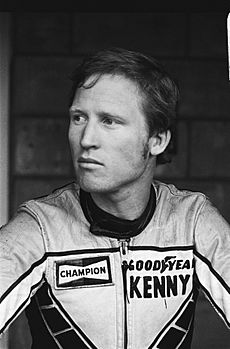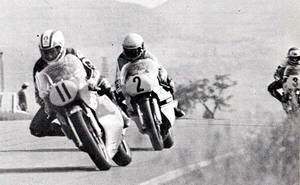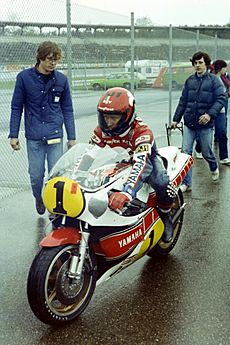Kenny Roberts facts for kids
Quick facts for kids Kenny Roberts |
|||||||||||||||||||||||||||||||||
|---|---|---|---|---|---|---|---|---|---|---|---|---|---|---|---|---|---|---|---|---|---|---|---|---|---|---|---|---|---|---|---|---|---|
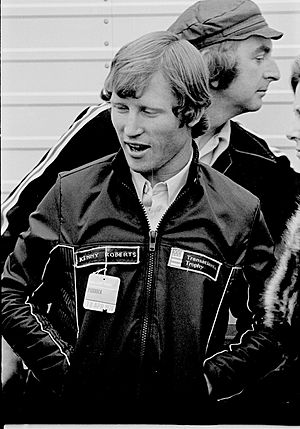
Roberts in 1975
|
|||||||||||||||||||||||||||||||||
| Nationality | American | ||||||||||||||||||||||||||||||||
| Born | December 31, 1951 Modesto, California |
||||||||||||||||||||||||||||||||
|
|||||||||||||||||||||||||||||||||
Kenneth Leroy Roberts (born December 31, 1951) is an American former professional motorcycle racer. He also owned a racing team. In 1978, he became the first American to win a Grand Prix motorcycle racing world championship. He also won the A.M.A. Grand National Championship twice. Kenny Roberts is one of only four riders in American Motorcyclist Association (AMA) history to win the AMA Grand Slam. This means he won races on different types of tracks.
Roberts made a huge impact on Grand Prix motorcycle racing. He was a world champion rider and fought for rider safety. He also owned a racing team and helped build motorcycle engines and frames. His unique riding style, learned from dirt track racing, changed how Grand Prix motorcycles were ridden. Roberts also helped racers get more power in the sport. This led to better safety and a more professional sport. In 2000, he was named a Grand Prix Legend. His son, Kenny Roberts Jr., also became a Grand Prix world champion in 2000.
Contents
- Early Life and First Rides
- Racing Career Highlights
- Starting in AMA Racing
- Learning a New Riding Style
- Becoming a Grand National Champion
- First Races in Europe
- Winning a Second National Championship
- The Famous 1975 Indy Mile Victory
- Later Grand National Career
- Becoming the First American World Champion
- The Rebel Leader
- Winning a Third World Championship
- A Change in Luck
- Roberts Versus Spencer: A Great Rivalry
- Career Achievements
- Race Team Manager and Owner
- Kenny Roberts' Legacy
- Honors and Awards
- Motorcycle Grand Prix Results
- See also
Early Life and First Rides
Kenny Roberts was born in Modesto, California. When he was a kid, he was interested in horseback riding. He rode his first motorcycle at age 12 after a friend dared him. He loved the thrill! He even built his own motorcycle using his dad's lawn mower engine and a bicycle frame.
Roberts started racing on dirt tracks after watching a local race. His dad bought him a Tohatsu bike. When it wasn't fast enough, he got a more powerful Hodaka motorcycle.
Roberts was a natural at dirt track racing and started winning. In 1968, a local Suzuki dealer, Bud Aksland, offered to sponsor him. Kenny decided to leave high school early to become a professional racer. On his 18th birthday, he entered his first professional race. He finished in fourth place.
Racing Career Highlights
Starting in AMA Racing
Kenny Roberts needed more help to grow his racing career. Bud Aksland introduced him to Jim Doyle, who became Roberts' manager. In 1971, Roberts became a sponsored rider for Yamaha at age 19. Yamaha asked Kel Carruthers, a former world champion, to guide Roberts. This started a long and successful partnership. Carruthers stopped riding in 1973 to focus on Roberts' motorcycles and mentor him.
The AMA Grand National Championship included different types of dirt track races and road racing. In 1972, Roberts won his second professional race in the Houston Astrodome. He also impressed people at the 1972 Daytona 200. He finished his first year ranked fourth in the country. He was known for battling the strong Harley-Davidson team on his less powerful Yamaha.
Learning a New Riding Style
In 1972, Jarno Saarinen was a top road racer. Roberts watched Saarinen's riding style. Saarinen would shift his body weight towards the inside of a turn. Roberts tried this technique and found it helped his motorcycle feel more stable. He started using this style and even leaned his knee out to skim the track. This new technique helped Roberts become excellent in road races.
Becoming a Grand National Champion
In 1973, Roberts won the AMA Grand National Championship in only his second year as an expert. Even though his Yamaha dirt track bike had less power than the Harley-Davidson bikes, he won three races. He consistently finished in the top ten.
First Races in Europe
In 1974, Roberts raced in the Daytona 200. He battled with former world champion Giacomo Agostini before finishing second. In April 1974, Roberts went to Europe for the first time. He raced in the Imola 200 and impressed everyone. He wore his bright yellow and black Yamaha USA team colors. He took the lead early but finished second to Agostini.
Roberts loved the large crowds and warm fans in Italy. European fans were amazed by his riding style. He would slide his rear tire, which was new to them. Italian journalists called him "Il Marciano," meaning "the Martian." This was because of his small size, yellow suit, and amazing riding.
Roberts then went to England to race in the 1974 Transatlantic Trophy series. This series matched American riders against British riders. Many thought American dirt track riders couldn't race as well on asphalt. Roberts proved them wrong by winning three of the six races. He was the top scorer, beating Barry Sheene, the best British rider.
After his success, Roberts made his world championship debut in the 250cc class at the Dutch TT in June 1974. He got the pole position and broke a seven-year-old lap record. He crashed but still finished third, getting on the podium.
Winning a Second National Championship
In 1974, Roberts won the San Jose Half-Mile dirt track race. He then won his first national road race at Road Atlanta. On August 18, he won the Peoria TT race. This meant he had won all five different types of events in the Grand National calendar, completing a "Grand Slam." He won his second Grand National championship in a row.
Roberts continued his road racing success in 1975, winning three of four races in the Transatlantic Match races. However, he faced tougher competition in dirt track races. Harley-Davidson improved their bikes, while Yamaha struggled. Roberts used his fearless riding style to make up for his bike's lack of power.
The Famous 1975 Indy Mile Victory
Roberts' daring riding style was clear at the 1975 Indy Mile Grand National. To keep up in the points race, Roberts and Carruthers put a powerful 170 mph Yamaha TZ750 road racing engine into a dirt track frame. Roberts had never ridden this bike before the race. He struggled to control the bike's massive power. He barely qualified for the main race, starting from the very last row.
Once the race started, he tried different ways to get traction. As he learned to control the powerful bike, he moved from last place through the field. His two-stroke motorcycle made a loud wailing sound that excited the crowd. He rode along the very edge of the track, sometimes clipping the hay bales. On the last lap, Roberts passed the Harley-Davidson riders Corky Keener and Jay Springsteen to win by inches. Afterward, Roberts famously said, "They don't pay me enough to ride that thing." The AMA then banned two-stroke motorcycles in 1976. Roberts later said this was his most important dirt track win.
Despite another Grand Slam, Roberts finished second in the 1975 national championship.
Later Grand National Career
In 1976, Roberts won four Grand Nationals. But he still had mechanical problems and less horsepower than the Harley-Davidson bikes. He finished third in the national championship.
In April 1977, Roberts returned to England and won four of six races in the Transatlantic Match races. He then won both legs of the Imola 200 in Italy, setting a new track record.
Back in the United States, he won five of the six road races in the Grand National championship. At Sears Point, Roberts started last and passed everyone within four laps to win. He finished fourth in the national championship that year.
Becoming the First American World Champion
In 1978, Yamaha USA sent Roberts to Europe to race in the World Championship Grand Prix road racing series. Kel Carruthers went with him as his crew chief. Roberts was unsure at first, but he realized Yamaha didn't have a competitive dirt track bike. He also got financial support from Goodyear tires.
Roberts planned to race in the 250cc and Formula 750 series to learn the tracks. But his main goal was the 500cc class, which was the top class. His main rivals were Johnny Cecotto and Suzuki riders Barry Sheene and Pat Hennen. Sheene had won the last two titles. Roberts decided to compete when he heard Sheene called him "no threat." Few people thought Roberts could win the championship in his first year.
Motorcycles in the late 1970s had powerful engines. But the frames and tires weren't as good. Roberts' riding style, learned on dirt tracks, changed road racing. Before him, riders would enter corners fast, brake late, and smoothly go through the turn. Roberts did the opposite. He would brake early, then quickly open the throttle. This made the rear tire slide. The bike would buck and shake as it lost and regained grip. This was a wild, powerful style no one had seen before in Europe. Because he opened the throttle early, he reached top speed faster than his rivals.
The 1978 season started with Roberts winning the Daytona 200. He then won a rain-shortened Imola 200 race.
The 1978 world championship chase started poorly for Roberts in Venezuela. He won the 250cc Grand Prix, but his 500cc Yamaha had a mechanical problem at the start. The championship then moved to Europe. Roberts faced problems with the FIM (the racing organization) at the Spanish Grand Prix.
Roberts realized that many race promoters were connected to the FIM. This meant there was little reason to make tracks safer. Roberts was used to AMA racing, where officials made sure tracks were safe. But in FIM races, riders had no such help.
At the 1978 Spanish Grand Prix, Roberts was almost not allowed to race in the 500cc event. Race promoters claimed they didn't know about his past 500cc experience. Roberts was angry, feeling the FIM was trying to control him. The FIM eventually let him race. He responded by getting the pole position and setting a lap record. In the race, he was leading by eight seconds when his throttle stuck open. He finished second.
Roberts then won his first 500cc Grand Prix in Austria. He quickly won two more races in France and Italy. He also had two second-place finishes. At the 1978 Swedish Grand Prix, Roberts crashed in practice and got a concussion and thumb injury. He finished seventh in the 500cc race. Sheene, his rival, closed the points gap.
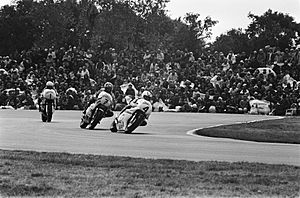
The two rivals arrived in England with only three points between them. The race ended with confusion due to heavy rain and pit stops. Roberts was declared the winner.
The final race was the German Grand Prix at the dangerous Nürburgring track. Roberts broke the lap record in practice. He qualified second and finished third, ahead of Sheene. This win made him the first American to win a world championship in Grand Prix road racing. He also finished second in the Formula 750 world championship and fourth in the 250cc world championship.
The Rebel Leader
The 1979 season started badly for Roberts. He suffered serious back injuries and a ruptured spleen in a crash in Japan. He missed the first race but made an amazing recovery. He won the second race in Austria, then finished second in Germany, and won again in Italy.
Roberts faced more problems at the Spanish Grand Prix. Race organizers refused to pay him starting money, which FIM rules guaranteed. An angry Roberts won the race. On the podium, he refused the winner's trophy. He told the promoters to sell it to help pay the racers' expenses.
The FIM first suspended Roberts, but later reduced it to probation. Roberts' action was a symbol of protest. It showed other riders that they could stand up to the FIM. This led to riders demanding better safety.
More problems happened at the Belgian Grand Prix. The track had just been paved, and many racers felt it was unsafe. Roberts and other top riders refused to race. The FIM suspended Roberts again, but later reduced it to probation. This showed the tension between Roberts and the FIM over track safety. Roberts also started talking to the press about creating a rival racing series.
The series then moved to Britain. Roberts was in one of the closest races ever. His battle with Sheene at the 1979 British Grand Prix is considered one of the greatest races of the 1970s. Just before the race, Roberts' Yamaha had an oil leak. His team fixed it, but his gloves were oily. This made his hand slip on the throttle during the race. Roberts and Sheene battled for the lead for 28 laps. Roberts won by only three-tenths of a second. A third-place finish in the final race secured his second world championship.
In December 1979, Roberts and other top riders announced they would leave the FIM. They planned to create a rival series called the World Series. When Roberts first came to Grand Prix racing, riders raced for little prize money. Tracks were often dangerous, with things like railroad crossings. Roberts challenged this poor treatment. The FIM reacted by condemning the new series. The rival series didn't fully happen, but the riders showed their power. The FIM was forced to take their demands seriously. New rules were passed, greatly increasing prize money. Stricter safety rules were also put in place for race organizers.
Winning a Third World Championship
In February 1980, Roberts returned to the American Grand National Championship for two races. He won the Houston TT race, tying a career record. He then finished third in the Houston short-track national. He also led the American team to victory over the British in the 1980 Transatlantic Match races.
For the 1980 Grand Prix season, Roberts' Yamaha USA team became the main factory team. Roberts won the first three races. His rivals, Randy Mamola and Marco Lucchinelli, started making it harder for him. Roberts' Yamaha had a flat front tire and a bad rear shock in the Dutch TT, forcing him to stop. But his main rivals also had problems. Suzuki riders won the last four races. However, Roberts had enough points to win his third 500cc world championship in a row.
A Change in Luck
In 1981, Yamaha introduced a new square-four cylinder bike. Roberts finished second in a non-championship race. He then won the next two Grand Prix races in Germany and Italy. But his title hopes suffered a setback at the Dutch TT. His front brake pads were put in wrong, causing his front wheel to lock up at the start. He missed the race. He came back to finish second in Belgium. Then, he got food poisoning and missed another race. He narrowly lost the British Grand Prix by a small margin. He finished the season in third place.
Roberts switched to Dunlop tires for the 1982 season. New competition arrived as Honda entered their new two-stroke NS500. Roberts won the first race in Argentina. He then switched to the new V4 engine Yamaha. He finished third in Austria. He and other top riders boycotted the French Grand Prix due to unsafe track conditions. Roberts then won the Spanish Grand Prix and finished second in the Dutch TT. Roberts was leading the Belgian Grand Prix when his tires lost grip. He finished fourth as Freddie Spencer won his first Grand Prix for Honda. Roberts then got injured and missed races. He finished fourth in the championship. By the end of 1982, Roberts had won sixteen 500cc Grand Prix races.
Roberts Versus Spencer: A Great Rivalry
Roberts announced that 1983 would be his last year in Grand Prix racing. Eddie Lawson joined as Roberts' new teammate. The 1983 championship battle between Roberts and Honda's Spencer was one of the greatest seasons in motorcycle Grand Prix history.
Roberts' Yamaha had problems early in the season. Spencer started strong, winning five of the first seven races. Roberts was leading the second race in France when his Yamaha lost power. Spencer won, and Roberts finished fourth. In Italy, Roberts crashed while leading Spencer. Roberts came back to win the German Grand Prix. He then finished second to Spencer in Spain. Roberts won the Austrian Grand Prix when Spencer's Honda had an engine problem. In Yugoslavia, Roberts' Yamaha didn't start right away. He fought through the field to finish fourth. Roberts then won three races in a row in the Netherlands, Belgium, and England. Spencer stayed close with a third place and two second-place finishes.
The championship moved to the Swedish Grand Prix. Spencer had a two-point lead over Roberts. Roberts led Spencer into the last lap. Spencer passed Roberts on the last corner. Both riders went off the track into the dirt. Spencer got back on track first and won the race. Roberts was angry, calling Spencer's pass dangerous. Roberts needed to win the final race and Spencer finish no better than third to win his fourth world championship. In a fitting end, Roberts won his last Grand Prix race. However, Spencer finished second, winning the world championship. Both riders won six races each that season.
Roberts continued to ride in some events in 1984. He won his second Daytona 200. In July, he won the first part of the Laguna Seca 200. In September 1985, he raced in a dirt track race but didn't make the final.
In July 1985, Roberts got the pole position at the Suzuka 8 Hours endurance race in Japan. He and his teammate were leading until mechanical problems dropped them to seventeenth place. Roberts returned in 1986 but didn't finish the race.
Career Achievements
In his 13-year professional racing career, Roberts won two Grand National Championships and three 500cc world championships. He won 32 Grand National races and 24 Grand Prix road races. He won the Daytona 200 three times and the Imola 200 three times. He also won the Laguna Seca 200 six times. He was the second AMA rider to achieve the Grand Slam.
Race Team Manager and Owner
After his racing career ended in 1983, Roberts decided to start a Grand Prix team. In 1984, he entered a team in the 250cc world championship. In 1986, he moved up to the 500cc world championship. Wayne Rainey joined the team in 1988. Rainey finished third in his first 500cc season and second in 1989.
In 1990, Roberts' team got support from Marlboro. His team became the official Yamaha factory racing team. Rainey and John Kocinski won the 500cc and 250cc world championships in 1990. This made Roberts the most successful team manager at the time. Rainey went on to win three 500cc world championships in a row for Roberts' team. After Rainey was injured in a crash in 1993, the Roberts team continued racing.
In 1997, Roberts left Yamaha after more than 25 years to start his own motorcycle company. He wanted to build his own bikes. He built a new bike with a three-cylinder engine. This bike got a pole position in 2002.
With the new MotoGP class in 2002, Roberts' team developed a five-cylinder bike called the KR5. The team struggled to compete with the big Japanese factories. In 2005, KTM provided engines, but they pulled out during the season. Honda then helped Roberts' team in 2006. Roberts' son, Kenny Roberts Jr., rode the bike to sixth place in the championship. In 2007, Roberts again got engines from Honda. But the results were not as good, and funding for the team ran out. After 2007, Roberts stopped competing in MotoGP.
Kenny Roberts' Legacy
Roberts' riding style, where he made the rear wheel slide to steer the motorcycle, changed Grand Prix racing. From 1983 to 1999, every 500cc world champion had a dirt track racing background. Roberts' way of leaning off the motorcycle with his knee out led to the invention of knee pucks, which all road racers use today.
His fights with the Grand Prix establishment led to stricter safety rules for races. He was one of the first riders to challenge the FIM. He helped improve prize money and made the sport more professional. It was only when Roberts planned his rival race series in 1980 that the FIM took riders' demands seriously.
Throughout his career, Roberts wanted to improve the image of motorcycle racing. He often returned to the United States to race in the Laguna Seca 200. He wanted this race to become a Grand Prix event. It eventually did in 1988. In 1993, Roberts even helped promote the United States Grand Prix. In the 1990s, when racing costs were high, Roberts demanded that Yamaha provide engines to smaller teams. This helped more racers compete.
Roberts' son, Kenny Roberts Jr., won the 500cc World Championship in 2000. They are the only father and son to have won the title. Roberts has said he considers himself a dirt tracker at heart. He only took up road racing because it was needed to compete for the Grand National championship.
Honors and Awards
- Inducted into the Motorsports Hall of Fame of America in 1990.
- Inducted into the International Motorsports Hall of Fame in 1992.
- Inducted into the AMA Motorcycle Hall of Fame in 1998.
- The FIM named him a Grand Prix "Legend" in 2000.
Motorcycle Grand Prix Results
Source:
| Position | 1 | 2 | 3 | 4 | 5 | 6 | 7 | 8 | 9 | 10 |
| Points | 15 | 12 | 10 | 8 | 6 | 5 | 4 | 3 | 2 | 1 |
(key) (Races in bold indicate pole position; races in italics indicate fastest lap)
| Year | Class | Team | Machine | 1 | 2 | 3 | 4 | 5 | 6 | 7 | 8 | 9 | 10 | 11 | 12 | 13 | Points | Rank | Wins |
|---|---|---|---|---|---|---|---|---|---|---|---|---|---|---|---|---|---|---|---|
| 1974 | 250 cc | Yamaha USA | TZ250 | GER - |
NAT - |
IOM - |
NED 3 |
BEL - |
SWE - |
FIN - |
CZE - |
YUG - |
ESP - |
10 | 19th | 0 | |||
| 1978 | 250 cc | Yamaha USA | TZ250 | VEN 1 |
ESP 2 |
FRA 2 |
NAT DNS |
NED 1 |
BEL - |
SWE - |
FIN - |
GBR - |
GER - |
CZE - |
YUG - |
54 | 4th | 2 | |
| 500 cc | Yamaha USA | YZR500 OW35K | VEN - |
ESP 2 |
AUT 1 |
FRA 1 |
NAT 1 |
NED 2 |
BEL 2 |
SWE 7 |
FIN DNF |
GBR 1 |
GER 3 |
110 | 1st | 4 | |||
| 1979 | 500 cc | Yamaha USA | YZR500 OW45 | VEN - |
AUT 1 |
GER 2 |
NAT 1 |
ESP 1 |
YUG 1 |
NED 8 |
BEL DNS |
SWE 4 |
FIN 6 |
GBR 1 |
FRA 3 |
113 | 1st | 5 | |
| 1980 | 500 cc | Yamaha Intl | YZR500 OW48 | NAT 1 |
ESP 1 |
FRA 1 |
NED DNF |
BEL 3 |
FIN 2 |
GBR 2 |
GER 4 |
87 | 1st | 3 | |||||
| 1981 | 500 cc | Yamaha Intl | YZR500 OW54 | AUT DNF |
GER 1 |
NAT 1 |
FRA 5 |
YUG 3 |
NED DNS |
BEL 2 |
RSM DNS |
GBR 2 |
FIN 7 |
SWE DNF |
74 | 3rd | 2 | ||
| 1982 | 500 cc | Yamaha Intl | YZR500 OW60 | ARG 1 |
68 | 4th | 2 | ||||||||||||
| YZR500 OW61 | AUT 3 |
FRA DNS |
ESP 1 |
NAT 4 |
NED 2 |
BEL 4 |
YUG DNS |
GBR DNF |
SWE DNS |
RSM DNS |
GER DNS |
||||||||
| 1983 | 500 cc | Marlboro Agostini Yamaha | YZR500 OW70 | RSA 2 |
FRA 4 |
NAT DNF |
GER 1 |
ESP 2 |
AUT 1 |
YUG 4 |
NED 1 |
BEL 1 |
GBR 1 |
SWE 2 |
RSM 1 |
142 | 2nd | 6 |
See also
 In Spanish: Kenny Roberts para niños
In Spanish: Kenny Roberts para niños



